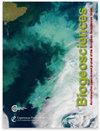缺氧环境中的底栖有孔虫和gromiids——生存策略、生物地球化学和营养相互作用
IF 3.9
2区 地球科学
Q1 ECOLOGY
引用次数: 1
摘要
摘要海洋正在失去氧气(O2),由于气候变暖(O2溶解度降低)和与农业有关的富营养化,氧气最低区正在扩大。这一趋势对不能很好适应氧气消耗的大多数海洋类群来说是具有挑战性的。对于其他红豆杉来说,这种趋势可能是有利的,因为它们可以承受低O2浓度,或者在O2耗尽甚至缺氧的条件下茁壮成长。底栖有孔虫是一组原生生物,包括能够适应部分极端环境条件的分类群。一些物种对氧气消耗有着罕见的适应性,这些物种可能会从正在进行的海洋脱氧中受益。此外,由于一些有孔虫即使在缺氧条件下也能钙化,它们是缺氧环境中古海洋重建的重要档案。本文综述了低O2环境中有孔虫的研究现状。总结并讨论了我们对有孔虫抵抗氧气消耗的特定生存策略的理解的最新进展。这些适应包括厌氧代谢、异养反硝化、与细菌共生、盗贼形成和休眠,并对它们在沉积物中的首选微栖息地,特别是一些底栖有孔虫物种的反硝化能力产生了强烈影响。底栖有孔虫的营养策略也不同,这对其微栖息地的选择有额外的影响。例如,一些物种是严格的食草动物,只以新鲜的植物碎屑为食,生活在沉积物表面附近,而一些物种是非选择性的食肉动物,占据着中深层的海底栖息地。有证据表明,即使在缺氧的情况下,有孔虫也有进行吞噬的能力,一些能够承受低O2条件的有孔虫物种似乎是小型动物的猎物。此外,由于底栖有孔虫在O2耗尽的环境中的高丰度及其代谢适应,它们是海洋营养循环的关键层,尤其是在海洋氮和磷循环中。这篇综述总结了已知反硝化物种的反硝化速率和已知细胞内储存硝酸盐的物种的细胞内硝酸盐浓度。最后,提供了可用于估计有孔虫细胞内营养物储存和反硝化速率的方程,并可将其整合到生物地球化学模型中。本文章由计算机程序翻译,如有差异,请以英文原文为准。
Benthic foraminifera and gromiids from oxygen-depleted environments – survival strategies, biogeochemistry and trophic interactions
Abstract. The oceans are losing oxygen (O2), and oxygen minimum zones are
expanding due to climate warming (lower O2 solubility) and
eutrophication related to agriculture. This trend is challenging for most
marine taxa that are not well adapted to O2 depletion. For other taxa
this trend might be advantageous because they can withstand low O2
concentrations or thrive under O2-depleted or even anoxic conditions.
Benthic foraminifera are a group of protists that include taxa with
adaptations to partly extreme environmental conditions. Several species
possess adaptations to O2 depletion that are rare amongst eukaryotes,
and these species might benefit from ongoing ocean deoxygenation. In
addition, since some foraminifera can calcify even under anoxic conditions,
they are important archives for paleoceanographic reconstruction in O2-depleted environments. This paper reviews the current state of knowledge
about foraminifera from low-O2 environments. Recent advances in our
understanding of specific survival strategies of foraminifera to withstand O2
depletion are summarized and discussed. These adaptations include an
anaerobic metabolism, heterotrophic denitrification, symbiosis with
bacteria, kleptoplasty and dormancy and have a strong impact on their
preferred microhabitat in the sediments, especially the ability of some benthic foraminiferal species to denitrify. Benthic foraminifera also differ
regarding their trophic strategies, which has an additional impact on the
selection of their microhabitat. For example, some species are strict
herbivores that feed exclusively on fresh phytodetritus and live close to
the sediment surface, while some species are non-selective detrivores that
occupy intermediate to deep infaunal habitats. There is evidence that
foraminifers have the capacity to undergo phagocytosis, even under anoxia, and some
foraminiferal species which can withstand low-O2 conditions seem to
prey on meiofauna. Also, due to their high abundances in O2-depleted
environments and their metabolic adaptations, benthic foraminifera are key
players in marine nutrient cycling, especially within the marine N and P
cycles. This review summarizes the denitrification rates for the species
that are known to denitrify and the intracellular nitrate concentrations of
the species that are known to intracellularly store nitrate. Finally,
equations are provided that can be used to estimate the intracellular
nutrient storage and denitrification rates of foraminifera and might be
integrated into biogeochemical models.
求助全文
通过发布文献求助,成功后即可免费获取论文全文。
去求助
来源期刊

Biogeosciences
环境科学-地球科学综合
CiteScore
8.60
自引率
8.20%
发文量
258
审稿时长
4.2 months
期刊介绍:
Biogeosciences (BG) is an international scientific journal dedicated to the publication and discussion of research articles, short communications and review papers on all aspects of the interactions between the biological, chemical and physical processes in terrestrial or extraterrestrial life with the geosphere, hydrosphere and atmosphere. The objective of the journal is to cut across the boundaries of established sciences and achieve an interdisciplinary view of these interactions. Experimental, conceptual and modelling approaches are welcome.
 求助内容:
求助内容: 应助结果提醒方式:
应助结果提醒方式:


